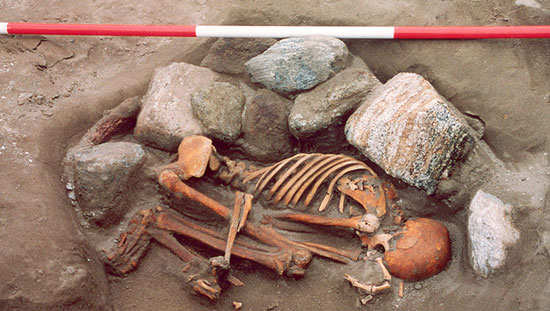Mummies grafted from parts of many people
Scientists have done DNA tests on prehistoric British mummies, showing that mummies are grafted from parts of different people, arranged like a person.
In 2001, four mummies discovered in South Uist in the Outer Hebrides of Scotland, were the first mummies in Britain to be assembled from parts of different people. It is the body parts that can be from people in the same family.
Researchers at Sheffield University are the first to discover the remains of a 3-month-old child, an adult woman and a woman of about 40 years old with a man in the village. Cladh Hallan prehistoric times.

Mummies are assembled from parts of many different people
Previously, University of Manchester researchers relied on pelvic structure that it was a mummy of women buried.
However, the mummy skeleton is actually a mixture . It has been assembled from 3 different people in some parts, such as the male skull. Through radioactive chronological analysis and mummy isotopes also showed that for mummies men also have such assembly phenomenon.
Based on the date of carbon radiation, Professor Mike Parker Pearson of the University of Sheffield said the mummies died 300-500 years before the tomb was built.
Subsequent tests showed that after death the bones were demineralized by placing the body in an acidic environment such as peat swamp about a year forming mummies.
Explaining this mummy transplant phenomenon, Professor Parker Pearson, an expert in Bronze Age rituals, said it could be relatives, should be assembled from different people. make a. Ancient people need to keep mummies to give spiritual support to the community.
Mr. Parker Pearson also believes that many other mummies in the UK also have this assembly phenomenon that archaeologists have missed.
- Mummies in China: Did white people come to the East more than 3,000 years ago?
- The most exotic ancient mummies in Vietnam
- Mysterious mummy '3,000-year-old Frankenstein' in Scotland
- Mysterious fate of two famous mummies
- Creating grafted tomatoes with disease resistance
- Ancient people also suffered from atherosclerosis
- The mysterious mummy survived for thousands of years, suddenly ... liquefied
- Found many strange mummies
- Catacombs contain more than 50 mummies of Egyptian royalty
- The boy found 'mummy' in the attic
- Shocking discovery of Egyptian mummies
- Successfully deciphered the tiny red face of ancient Egypt
 Discovered an ancient centipede fossil 99 million years old
Discovered an ancient centipede fossil 99 million years old Discovered bat-like dinosaurs in China
Discovered bat-like dinosaurs in China Discovered a 200-year-old bronze cannon of the coast
Discovered a 200-year-old bronze cannon of the coast Discover 305 million-year-old spider fossils
Discover 305 million-year-old spider fossils